Invasive Weeds in Saskatchewan:
Field Scabious (Knautia arvensis)
The Field Scabious is also known as Blue Buttons and is classified as a prohibited weed in Saskatchewan.
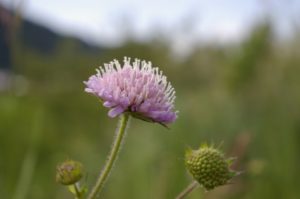
These weeds can grow up to 60 inches tall. They have small pale flowers that are pale blue – purple which are clustered into half sphere heads on leafless branches. There are typically very few flower heads per plant and flowers bloom June into early fall.
This weed is commonly found in: riparian areas, tame forage, waste areas, native prairie, abandoned cropland, yard sites, cropland, roadsides, and gravel pits. They can be identified by their half-sphere flower heads and slightly branched stems with hairy leaves.

It is a perennial with a single stem and tap root system. Its leaves are usually 4 to 10 inches long; the rosette leaves are jaggedly toothed while the steam leaves are on opposite sides of the stem and are deeply lobed. The stem is covered in stiff hairs and is tall and slightly branched.
These are a problem us because they create competition for native vegetation in the area. Livestock will also choose not to eat these plants.
Since this weed is considered prohibited, if you identify
one you must report it to your local R.M. within 5 business days of the sighting. This allows the weeds to be kept under control as much as possible.
*Information from Saskatchewan Invasive Plant Species Identification Guide*
*Pictures from Invasive Species Council of BC*
Eurasian Water-Milfoil
The Eurasian Water-Milfoil is an aquatic invasive plant. It is native to Europe, Asia and northern parts of Africa; it was introduce to North America in the 19th century. Since its introduction it has become one of the most widely spread invasive aquatic plants on the continent. It was spread to North America either through the aqua rium trade or the ballast water of ships.
rium trade or the ballast water of ships.
The plant prefers shallow waters of 1-3 meters deep; however it can survive in up to 10 meters of water. They form dense underwater mats of vegetation which shades other plants. It can also interbreed with native varieties of milfoil, creating a superior invasive species.
This weed is hard to control due to its ability to regrow from a small portion of itself. It is easily spread by boats, water currents, trailers and fishing gear. In the fall when large pieces die off and fall into the water the decomposing process uses a large amount of oxygen in the water, limiting the amount available to aquatic organisms.
There are a variety of negative impacts to having this species around. It reduces biodiversity by competing with native vegetation. It reduces water flow creating an excellent habitat for mosquitoes. The thick mats also make it difficult to engage in recreational activities in the water.

They can be identified by their green feather-like leaves that circle around the stem. They bloom from late July to early August and have very small, reddish flowers that rise above the water.
Since the Eurasian Water-Milfoil is classified as a prohibited weed in Saskatchewan, if you identify one you must report it to your local R.M. within 5 business days of the sighting. This process helps keep these invasive weeds in control as much as possible and prevent further spreading.
*Information from Ontario’s Invading Species Awareness Program*
*Pictures from cayugacountry.us and Ontario’s Invading Species Awareness Program*
Absinthe (Artemisium absinthum)
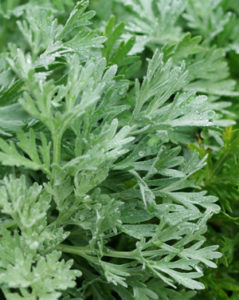
Absinthe is also commonly known as Wormwood or Wormwood Sage. This weed is a perennial and the top growth of the plant dies yearly. It is typically a greenish-grey, tap root weed with multiple stems.
The leaves are usually 1-3 inches in length and are also greenish-grey in color. They are very deeply
segmented and are covered in silky hair. The leaves tend to be near the base on long stalks and up higher on shorter stalks. They also alternate sides along the stem.
It can grow up to 60in tall and has many stems that sprout from the base. The stems are also green-ish grey in color and are wooly and grooved.
The weed produces small yellowish flowers in clusters in late June through

September. These clusters are typically 0.08-0.12 inches in diameter. Although these flowers are plentiful, they are inconspicuous. These weeds like to grow in tame forage, waste areas, yard sites, cropland, roadsides and even gravel pits.
Absinthe can be identified by its distinct sage like odour. The leaves are also deeply segmented and hairy on stems from a rosette. This weed competes with other vegetation, limiting native plants ability to grow. It also is not liked by livestock, making hay less useful in its presence.
*Information from Saskatchewan Invasive Plant Species Identification Guide*
*Pictures from Strictly Medicinal Seeds and Love Light Herbs*
Baby’s Breath (Gypsophila paniculata)
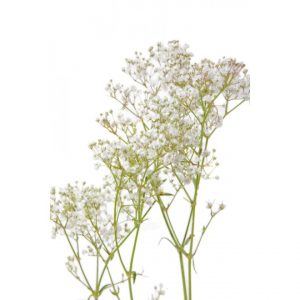 Baby’s Breath is commonly used in the florist industry, however in Saskatchewan it is considered an invasive weed. It is a perennial plant with a thick and deep root system. It has many open branched stems with tons of tiny flowers.
Baby’s Breath is commonly used in the florist industry, however in Saskatchewan it is considered an invasive weed. It is a perennial plant with a thick and deep root system. It has many open branched stems with tons of tiny flowers.
Its leaves are 1-4 inches long and tend to be blue-green to grey-green with small hairs. They are lance shaped and narrow with a single vein. The leaves fall on opposite sides of branched, slender stems. The stems are swollen where the leaves attach.
These weeds can reach 12-36 inches tall. The white flowers have 5 petals and are very small. These flowers give the weed a ‘puff ball’ appearance. The flowers appear for the first time in the 3rd year and bloom June through August.
These plants will take over any areas that they can, however the most common are tame forage, native prairie, roadsides, waste areas and gravel pits. Baby’s Breath comes into an area and crowds out the native vegetation. It can be identified by its highly branched stems and sparse, small white flowers.
*Information from the Saskatchewan Invasive Plant Species Identification Guide*
*Pictures from Flower Muse and CalPhotos*
Downy Brome (Bromus tectorum)
Downy Brome is also commonly known as Cheat Grass, Thatch Bromegrass, Early Chess and Downy Chess. It is a purplish coloured winter or summer annual grass. It has fibrous roots and usually grows in dense patches. It sticks out by the seeds drooping to one side.
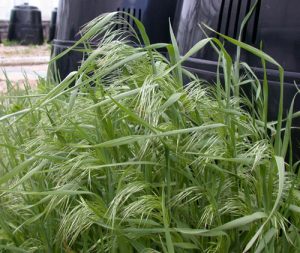
This grass can reach heights of 3-24 inches and has slender and hairy stems. The stems and flower both have a purplish tinge. The flowers are spikelets of 4+ on twisting branches that head out May through June. These spikelets droop to one side giving this grass a distinct look. The spikelets also have long straight to slightly bent awns.
It is similar to Japanese Brome Grass but can be identified by its smaller seeds, it has no silky hairs on the ligule and spreading look of drooping seed heads.
Downy Brome likes to settle in tame forage, native prairie, yard sites, cropland, waste areas and roadsides. It is considered invasive and with displace native vegetation, reduce crop yields, increases chance of wildfire and the awns can cause injury to livestock.
*Information from the Saskatchewan Invasive Plant Species Identification Guide*
*Pictures from City of Edmonton and The Equinest*
Scentless Chamomile (Matricaria perforata)
Scentless Chamomile is a classified as a native species in Saskatchewan. It can also commonly be known as Scentless Mayweed and Scentless False Mayweed. It can be annual of biennial, has very dense fibrous roots and produces white daisy-like flowers.
Its stems are hairless, highly branched and tend to curve upwards. While the leaves are smooth and divided finely, similar to carrots. They alternate on the stem and typically do not have stalks. The leaves if crushed are also scentless.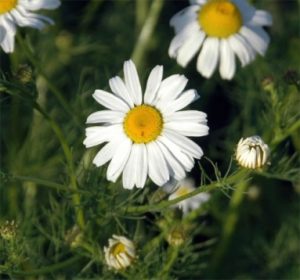
This plant can grow anywhere from 6 to 36 inches tall. It produces flowers that are similar to daisies with a yellow center surrounded by white petals. There is one flower on the tip of each stem and they tend to be 0.8 to 1.6 inches wide. The flowers usually bloom late May through November.
These weeds will grow just about anywhere which is one of the main issues with invasive plants. It will settle in roadsides, yards, riparian areas, cropland, tame forage, native prairie, waste areas and even gravel pits.
The major impact of having this weed around is that is outcompetes native and desired vegetation. It can be identified by its daisy like flowers and leaves that produce no odor when crushed and are finely divided.
*Information from Saskatchewan Invasive Plant Species Identification Guide.*
*Pictures from City of Edmonton and Invasive Species Council of BC*
Oxeye Daisy (Leucanthemum vulgare)

The Oxeye Daisy is considered an invasive weed in Saskatchewan. It is also commonly known as White Daisy, Field Daisy, Dog Daisy and Moon Penny. It is a perennial with shallow roots and daisy like flowers. There are numerous stems that curve from one base. It reproduces through creeping root or seeds, there is an average of 859 000 seeds per pound of plant.
The leaves on the lower portion of the plant are dark green, have stalks, and are spoon-shaped and toothed. The leaves on the upper portion of the plant have no stalks and are much narrower. The leaves are smooth and tend to be smaller the farther up the stem they are and alternate along the stem.
This weed can typically grow 8 to 35 inches tall; however in riparian areas it can reach over 40 inches tall. Its stems are hairless and are straight or have a slight upwards curve.
The flowers are at the tips of stems and the main branches and look similar to daisies. The centers are yellow with long white petals. The base of the flower head has overlapping, light green bracts. These flowers bloom early June to late fall.
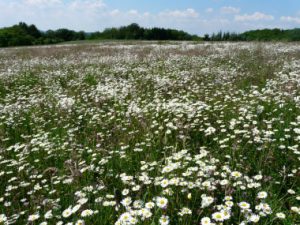
These weeds can survive and will settle just about anywhere which makes them a species we want to control. They will live on roadsides, cropland, abandoned cropland, hay land, tame pasture, native prairie and riparian areas.
Due to this being an invasive species it has some major impacts in our province. The seeds can float
making it easy for them to travel along rivers and disperse to new areas. Once established it can form dense infestations that are difficult to control and remove.
This weed can be identified by its daisy like flowers and dark green, glossy leaves. If you crush any part of the plant it will also give off a very sour odor. This is a good distinguishing factor between Scentless Chamomile and Oxeye Daisy as Scentless Chamomile is scentless when crushed.
*Information from Saskatchewan Invasive Plant Species Identification Guide*
*Pictures from Emorsgate Seeds and Edible Wild Food*
Purple Loosestrife (Lythrum salicaria)
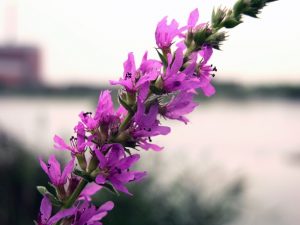
Purple Loosestrife is an invasive species in Saskatchewan, It is also commonly known as Lythrum and Purple Lythrum. It is a wetland perennial and possesses both tap root and creeping root systems. Stems are square shaped and produce spikes of magenta flowers.
The leaves are dark green and either appears on opposite sides of the stem or in 3’s. They are narrow, attached directly to the stem and have smooth edges with a rounded base.
The stems are square shaped but can sometimes be 5 or 6 sided. They tend to be hairless to slightly hairy and one individual plant can produce more than 30 stems.
Each flower has 5 to 7 magenta coloured petals around a tiny yellow center. These flowers are grouped into spikes at the top of the stems. The flowers appear July through September.
These plants tend to live in wetlands and riparian areas and can grow to be 2 meters tall. They can be identified by their square stems, magenta flowers and narrow stalkless leaves.
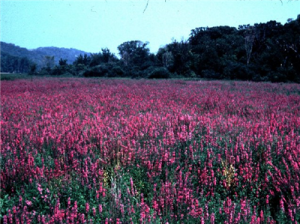
They were introduced as an ornamental flower in the 1800s and have dispersed since then. The possibility of this plant disperses seeds into the wild makes it a hazard to have in an ornamental setting.
Purple Loosestrife can be particularly hard to control. Each plant can produce over 3 million seeds a year. It can also regenerate from a small piece of root left in the soil. This plant has the ability to choke out native vegetation and take over an entire wetland.
*Information from Saskatchewan Invasive Plant Species Identification Guide*
*Pictures from LuontoPortti and Wisconsin Sea Grant*
Wild Parsnip (Pastinaca sativa)
The Wild Parsnip is an invasive weed in Saskatchewan. It is a biennial and reproduces only by seed. It has a thick white to yellowish taproot system. Plants remain as a rosette for their first season.
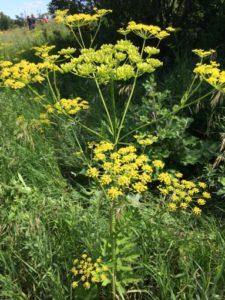
Its leaves are compound with 2 to 5 pairs of opposite, sharply toothed and broad leaflets. The leaves alternate with one at each node. The seedlings have small leaves and are on long stalks.
It produces flowers that are yellow and small that cluster in compound umbels. The seeds have a round outline and are in a flat wing. The flowers bloom from late May to late fall.
These weeds will grow anywhere making them an invasive to keep an eye on. They will grow in abandoned yards, waste areas, meadows, oil fields, roadsides and railway embankments.
They can be identified by their yellow flowers, distinct color and compound stem leaves. If you identify this weed, report it to IMap invasives. It is important to report any invasive or prohibited species that you find as it is a key part in controlling the spread of invasive species in our province.
*Information from Saskatchewan Invasive Species Identification Guide*
*Pictures from The Echinacea Project and the State of Michigan*
Dame’s Rocket (Hesperis matronalis)
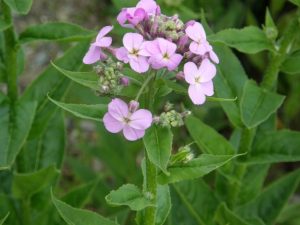
Dame’s Rocket is an invasive weed in Saskatchewan. It is also commonly known as Common
Dames Violet, Sweet Rocket and Mother-of-the-Evening. It can be biennial or perennial and is a rosette in its seed
ling year. In its second year it is single or multi-stemmed with a tap root system. It is tall, dark green, produces seeds and is in the mustard family.
The leaves are usually 2 to 6 inches in length and 0.4 to 1.6 inches wide. They are hairy and dark green with jagged, toothed edges. The leaves tend to get smaller the higher on the stem they are. They are oblong in shape and alternate on the stem.
This weed can grow to be 39 inches tall and may exceed this in riparian areas. The stems are hairy, stiff and branch at the top. There is occasionally more than one stem per plant.
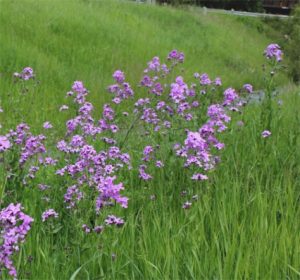
The flowers each have 4 petals and are typically purple, but white and pink varieties do exist. These flowers are fragrant and form clusters at the end of branches. The flowers appear May through July.
Being an invasive weed these plants can live almost anywhere. They settle in riparian areas, gardens, shorelines, abandoned cropland, wooded areas, shrub bluffs, native prairie, coulees, yard sites and waste areas.
Most invasive species have a negative impact on our native ecosystems. These weeds over crowd areas due to the large number of seed they produce, pushing out the native vegetation. They also take over riparian areas decreasing their overall health. Dame’s Rocket can be identified by their fragrant 4 petal flowers in cluster and alternating leaves.
*Information from Saskatchewan Invasive Species Identification Guide*
*Pictures from Invasive Species Council of BC and City of Edmonton*
Leafy Spurge (Euphorbia esula)
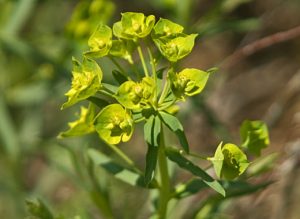
Leafy Spurge is classified as an invasive weed in Saskatchewan. It is a perennial that possesses a tap root and creeping root system. They have distinct bright bracts that come out in June on the tops of the plant. It is a single stemmed plant that grows in a cluster.
The leaves typically are 0.25 to 1.5 inches long. They are hairless and green in colour. They alternate on the stem and are long and narrow. The flowers are small, a yellowish green and almost unnoticeable. They lack petals and are no more than 0.12 inches wide. The flowers appear in the end of June and continue to flower until fall. They are surrounded by bracts which appear in early June and are very distinct.
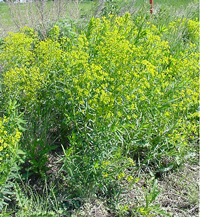
They are an invasive species that can be difficult to control. This weed can spread very quickly and is hard to stop due to its root system. Even a small part of the root system left behind can sprout a new plant. Their roots can be as deep as 8 meters which gives them an advantage by having access to nutrients and water other plants do not. The roots spread laterally under the soil at a rate of up to 4.5 meters a year. Due to these factors once this weed is established it is almost impossible to remove.
It will out compete native vegetation and take over the habitat. It poses another problem when invading farmland since it can be toxic to cattle and horses. It can be identified by breaking the stems or leaves and looking for milky sap. Be careful however because this sap can cause rashes on humans and is toxic to animals. There currently are two biological control methods that are being used on this invasive species: Leafy Spurge Flea Beetles and Spurge Hawk Moths.
*Information from Saskatchewan Invasive Species Identification Guide*
*Pictures from The Idaho Weed Awareness Campaign and the Government of Saskatchewan*
Common Tansy (Tanacetum vulgare)

Common Tansy is considered an invasive weed in Saskatchewan. It is also commonly known as Garden Tansy and Yellow Buttons. It is a perennial and has a tap and creeping root system with rhizome growth. It has yellow, flat topped, button-like flowers with a distinct smell.
The leaves tend to be 4 to 8 inches long and fern like. They have jagged, deep lobed segments and are on short stalks. They possess a strong smell and alternate on the stem.
These weeds can be 18 to 36 inches tall and have branched, purplish stems. They are usually dotted with small glands and multiple branches grow from the same root. The flowers bloom July through Septembers and are grouped on the top of the plants. They are yellow and similar to daisies without the white petals.

Invasive weeds usually cause many issues for native ecosystems. These weeds over crowd native vegetation and make it impossible for it to grow. Livestock tend to avoid Common Tansy making fields invaded by it less useful. If eaten by livestock it can also have very harmful effects including abortions and in rare cases death.
This weed can be identified by its button like flowers that resemble the center of a daisy as well as its sharply toothed leaves. If you come across this weed on your property, report it to IMap invasives. Keeping track of where invasive weeds are is a step towards controlling them.
*Information from Saskatchewan Invasive Plant Species Identification Guide*
*Pictures from The Spruce and the City of Edmonton*
Canada Thistle (Cirsium arvense)
The Canada Thistle is considered and invasive weed in Saskatchewan. It is also commonly known as California Thistle, Field Thistle and Creeping Thistle. It is a perennial with tap and creeping root systems. It disperses quickly and tends to grow in patches. The plants of this species are either male or female. 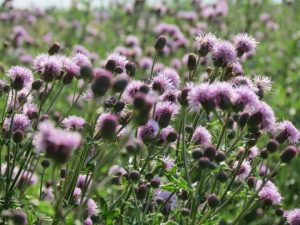
The leaves are light to dark green and have hairless undersides. They are numerous and alternate on the stem. They are long and have spine-toothed lobes that have an irregular shape. The stems are wingless and can be slightly prickly. They are also light to dark green and the plant can reach a height of 48 inches.
The flowers bloom throughout the summer, are tubular and range from rose-purple to pink-white. There are numerous flower heads per stem and have almost spineless bracts. The male flowers are usually globe-shaped while the female flowers are flask-shaped and occur on different plants.
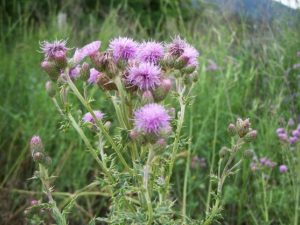
Being an invasive weed they can survive almost anywhere. They are most commonly found in riparian areas, tame forage, native prairie, fence rows, waste areas, yard sites, cropland, road sides and even gravel pits.
These weeds can have a major impact on natural ecosystems. They tend to overtake areas where native vegetation grows and out compete the other vegetation for space and resources. There dispersal can be hard to control due to the fact they can regrow from a small portion of their roots left behind.
*Information from Saskatchewan Invasive Plant Species Identification Guide*
*Pictures from Invasive Species Council of BC and Edmonton and Area Land Trust*
Yellow Toadflax (Linaria vulgaris)
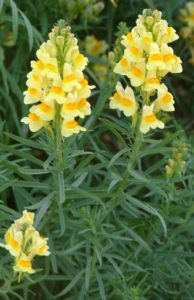
Yellow Toadflax is classified as an invasive weed in Saskatchewan. It is also commonly known as Butter and Eggs, Jacob’s Ladder and Wild Snapdragon. It is a perennial that has a creeping and tap root system. The flowers closely resemble those of Snapdragon’s. When the stems or leaves are broken a clear to slightly milky juice is produced.
The leaves are typically 0.75 to 4 inches in length. They are waxy, hairless and pale to silvery green. They are long and narrow in shape and have short leave stems. They alternate on the stem however they may appear to be opposite when the stem is crowded.
These weeds can grow to be 4 to 36 inches in height. The stems are hairless and a woody red colour at the base and slightly hairy and green at the top. The flowers have orange centers and light yellow petals. They resemble Snapdragon flowers and have a spur at the base of the flower. They tend to cluster in spikes at the top of stems. The flowers typically bloom from late June through August.

Invasive weeds usually have negative impacts on natural ecosystems of native vegetation. This weed in particular can be toxic to livestock, invades areas and pushes out native vegetation. It also has the ability to breed with Dalmatian toadflax creating a hybrid species.
The Yellow Toadflax can be identified by its Snapdragon like flowers, long a narrow leaves on short stems and it tends to grow in dense patches. If you come across this species report it to your local R.M. or IMap invasives. Tracking of invasive weeds is an important step towards controlling them.
*Information from Saskatchewan Invasive Plant Species Identification Guide*
*Pictures from Teton County Weed and Pest and City of Edmonton*
